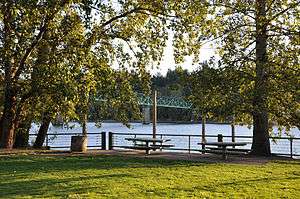Sellwood, Portland, Oregon
| Sellwood-Moreland | |
|---|---|
| Neighborhood | |
|
Sellwood Park along the Willamette River | |
| Country | United States |
| State | Oregon |
| City | Portland |
| Government | |
| • Association | Sellwood Moreland Improvement League (SMILE) |
| • Coalition | Southeast Uplift Neighborhood Program |
| Area | |
| • Total | 1.81 sq mi (4.68 km2) |
| Population (2000)[1] | |
| • Total | 10,475 |
| • Density | 5,800/sq mi (2,238/km2) |
| Housing[1] | |
| • No. of households | 5159 |
| • Occupancy rate | 96% occupied |
| • % households renting | 48% renting |
| • Avg. household size | 2.03 persons |
Sellwood-Moreland is a neighborhood on a bluff overlooking the Willamette River in Southeast Portland, Oregon, bordering Westmoreland to the north, Eastmoreland to the east, and the city of Milwaukie to the south. Sellwood originated as an independent city, as a rival of nearby early Portland on the 1,320-acre (5.3 km2) Donation Land Claim of Reverend John Sellwood, who sold the claim in 1882 to the Sellwood Real Estate Company.[2] The town of Sellwood was incorporated by the Oregon Legislative Assembly on February 25, 1889.[3] It was annexed by the city of Portland in 1893.
The neighborhood is linked to Southwest Portland across the Willamette by the Sellwood Bridge, the southernmost of Portland's bridges. The bridge is currently in the process of being replaced, scheduled for completion in early 2016.[4]
Sellwood has an amusement park named Oaks Park along the river. A bike trail next to railroad tracks above the river is accessible from Sellwood, and links Milwaukie and downtown Portland. The Oaks Bottom Wildlife Refuge was established in 1988 and has allowed the preservation and protection of numerous species. Varieties of birds include mallard and other ducks, blue herons, kingfishers and others. Walking trails go through the park, traversing woods, meadow and marshland.
Milwaukie Avenue and SE 13th Avenue are the locations of many restaurants, Moreland Theater, specialty retail and neighborhood stores, upscale antique shops along the Antique Row on SE 13th, as well as groceries, hardware store and shoe repair shop. The pedestrian neighborhood is organized around the retail corridors, an example of the communities the city is trying to encourage.
References
- 1 2 Demographics (2000)
- ↑ Snyder, Eugene E.. Portland Names and Neighborhoods: Their Historic Origin. Portland: Binford & Mort, 1979. p. 202.
- ↑ Baker, Frank C. (1891). "Special Laws". The Laws of Oregon, and the Resolutions and Memorials of the Sixteenth Regular Session of the Legislative Assembly Thereof. Salem, Oregon: State Printer: 1007.
- ↑ http://www.sellwoodbridge.org/
External links
| Wikimedia Commons has media related to Sellwood, Portland, Oregon. |
- PDF map
- Guide to Sellwood-Moreland Neighborhood - PortlandNeighborhood.com's Sellwood-Moreland page
- The Sellwood Bee - Sellwood's local paper
- Share-It Square - A City Repair Project intersection repair
Coordinates: 45°27′54″N 122°39′00″W / 45.465°N 122.65°W

